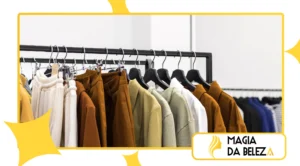Slow Fashion vs Fast Fashion: Why Quality Matters More Than Ever

In today's fashion world, the battle of giants between the Slow Fashion vs. Fast Fashion has never been so relevant.
Advertisements
With rapidly changing trends and the pressure for constant consumption, many get lost in the whirlwind of new things.
However, deep reflection reveals that the pursuit of quality, rather than quantity, is the most promising path.
The Reign of Unbridled Consumption: The Face of Fast Fashion
In this sense, the business model of fast fashion is intrinsically linked to speed and volume.
It relies on mass production and rapid distribution of clothing, imitating the latest catwalk trends at affordable prices.
Advertisements
In other words, this feeds a vicious cycle of buying and discarding, where parts are seen as disposable.
This system, although seductive, has a very high environmental and social cost.
Large-scale production consumes enormous amounts of water and energy, in addition to generating textile waste in alarming proportions.
Working conditions in many factories are deplorable, with exhausting workdays and unworthy wages.
It's an unsustainable model that leads us to accumulate items that we often don't even use.
The illusion of constant “newness” prevents us from valuing what we already have.
After all, the clothes we bought last week already look old compared to tomorrow's new release.
A Quiet Revolution: The Rise of Slow Fashion
On the other hand, the slow fashion emerges as a resistance movement.
He advocates a more conscious and ethical approach to fashion, prioritizing durability, quality, and transparency. The philosophy is simple: buy less, buy better.
Slow fashion pieces are often handmade or made in small batches, using high-quality materials and featuring a timeless design.
The idea is to create clothing that stands the test of time, both in style and structure. The connection between the consumer and the item is valued.
In this sense, think of a shoemaker who builds a pair of leather shoes that last decades, rather than a plastic sneaker that falls apart in a few months.
The same logic applies to slow fashion: artisanal mastery and high-quality materials are prioritized. This applies not only to the final product, but to the entire process.

Quality as an Investment and Criticism of Cost-Benefit
When we evaluate the cost-benefit, fast fashion may seem like a more advantageous option in the short term.
However, it's crucial to reevaluate this metric. Is a fast-fashion dress, priced at R$ 50, that falls apart after three washes, really cheaper than a slow-fashion dress, priced at R$ 300, that lasts five years?
Find out more: Future Careers: Courses That Guarantee Stability and Good Salaries
The durability of a slow fashion piece translates into a long-term investment.
Furthermore, the raw materials and production method are designed to minimize environmental impact.
According to McKinsey's 2020 "Fashion on Climate" report, the apparel and footwear sector is responsible for approximately 4% to 8% of global greenhouse gas emissions. This data highlights the urgency of change.
| Feature | Fast Fashion | Slow Fashion |
| Production | Fast, in bulk | Slow, on a small scale |
| Durability | Low, disposable | High, durable |
| Environmental Impact | High | Low |
| Materials | Synthetics, low quality | Natural, high quality |
This table illustrates the fundamental dichotomy between the two models. While one prioritizes speed and cost, the other values longevity and ethics.
Read more: Women's mental health
The consumption decision becomes a vote on which of these futures we want.
Conscious Consumption as an Ally of Quality Slow Fashion vs Fast Fashion
The choice between Slow Fashion vs. Fast Fashion goes beyond aesthetics. It's a decision that reflects values.
Therefore, it's an attitude that aligns with our responsibility as global citizens. It's about questioning whether what's behind the label represents us.
A good example is the trajectory of organic cotton. Conventional cotton requires large amounts of water and pesticides, which contaminate the soil and rivers.
Organic cotton, grown without the use of chemicals, represents a healthier alternative for the environment and for people.
See how interesting: How to create graphic eyeliner: ideas for daring makeup
The quality of a slow fashion piece also lies in its history.
For example, a shirt made by an artisan in a local workshop, using sustainable fabrics and natural dyes, carries with it a narrative of care and value.
This narrative is lost in the sea of identical fast fashion pieces.

The Future of Fashion and Our Role
Therefore, the future of fashion isn't about having a wardrobe full of disposable items. It's about having a wardrobe filled with pieces we love, that last, that tell a story.
THE Slow Fashion vs. Fast Fashion It is not just a trend, but an evolution.
We, as consumers, are agents of change. How we spend our money is a vote.
By choosing a quality item, we're investing in a more sustainable and fair world. Fashion can and should be a force for good. What do we want for our future?
Frequently Asked Questions Slow Fashion vs Fast Fashion
1. Is slow fashion accessible?
While slow fashion pieces may have a higher initial price tag, their durability and superior quality mean you buy less and the pieces last longer, which translates into savings in the long run.
2. How can I identify slow fashion brands?
Look for brands that are transparent about their production practices, use sustainable materials, and value artisanal work. Research is key.
3. Can I mix fast and slow fashion pieces?
Yes. The idea of slow fashion is about awareness, not exclusivity.
Reducing your consumption of fast fashion and incorporating more quality pieces into your wardrobe is already a big step.
++ Slow fashion and Fast fashion: get to know these two concepts
